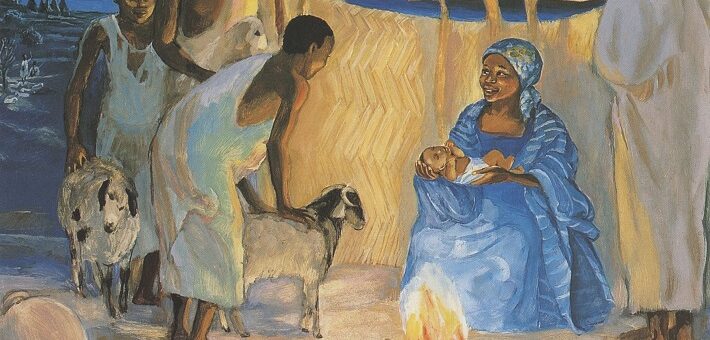Commentary on Luke 2:8-20
Luke 2:1–14, the Narrative Lectionary’s reading for Christmas Eve, presents the birth of a child to an unassuming couple in an unusual place. I suggested in the commentary for that text that Luke presents the social world of the Roman Empire in miniature, from the powerful Emperor to a vulnerable infant; from the top of the social scale to the bottom. The fact that the “hero” of this passage is a child, an infant, and not the powerful male first introduced (the emperor), should shake up our sensibilities about who God is.
The reading for Christmas day, Luke 2:8–20, now presents those at the bottom of the social scale as the first to hear the news of this child’s birth. In the announcement of Jesus’ birth to the shepherds, Luke uses the word “infant” or “baby” (2:12, 16; though the NRSV translates the Greek as “child,” instead) foreshadowing one of Luke’s themes of reversal. The pattern of reversals that Mary proclaims in her song of praise (Luke 1:46–55) will be expressed in a variety of ways throughout the Gospel, including in Jesus’ welcome of children, “even infants” (18:15–17). It is reinforced again as the news of the child’s birth is announced first to a group of shepherds, who were persons of low social status in the ancient world. Children were also low status persons in the ancient world. This baby, however, whom the angels announce, is the savior, the Christ, the Lord. There is hardly a more shocking reversal that Luke could have used.
As with many biblical characters whose age and gender are undefined, “shepherd” likely evokes the image of a male, perhaps an older man, in the mind of the modern reader. However, in the ancient world both males and females tended goats and sheep, including children. A variety of ancient writers mention the kinds of agricultural related work which children performed: tending flocks and herds, working in vineyards, trimming and pruning vines, tending olive groves, weeding gardens and collecting firewood. This is not unlike the farm work which some children perform today around the world.
Amy Lindeman Allen states that “children participated in the welfare of their respective households through the task of shepherding.”1 She discusses further that several children in the Hebrew Bible are described as shepherds such as Rachel (Genesis 29:6–9) and David, the shepherd boy soon to be king (1 Samuel 16:11). Even Jesus is depicted in later Christian texts as doing agricultural related work: The Infancy Gospel of Thomas has a brief episode in which a young Jesus multiplies the one measure of wheat he sowed to become 100 measures, and the third century text Refutation of All Heresies includes a story about an angel visiting Jesus as a twelve-year-old child feeding sheep.
In the Jewish context of the time, shepherds were not considered outcasts or unclean, though they were among the lowest status laborers of the day. In the Greek and Roman political traditions, however, the shepherd is a commonplace reference to kings and emperors.2 In the Roman Empire, the emperor was to rule the people like a shepherd cares for his flock.3
The New Testament draws upon this image of the shepherd ruler in numerous places. In
Revelation 12:1–5, John of Patmos presents a mythological narrative of Jesus’ birth. The chapter begins with a description of two signs in the heavens: a woman clothed with the sun, who is about to give birth, and a dragon, hovering nearby ready to devour the child as soon as it is born. The woman, who has been writhing in labor pains and anguish (unlike Luke’s description of Mary!), finally delivers the baby. The next verse is a highly condensed account of Jesus’ birth to his ascension: “And she gave birth to a son, a male child, who is to rule all the nations with a rod of iron. But her child was snatched away and taken to God and to [God’s] throne” (Revelation 12:5, NRSV, alt.). John describes this male child as “about to rule the nations with a rod of iron.” John draws language from Psalm 2, which the early Christ-followers applied to their understanding of Jesus.
The Gospel of Matthew also refers to a shepherding ruler: “for so it has been written by the prophet: ‘And you, Bethlehem, in the land of Judah, are by no means least among the rulers of Judah; for from you shall come a ruler who is to shepherd my people Israel’” (Matthew 2:6). Both Matthew and John of Patmos indicate that the metaphor of shepherding was important to the early Christian understanding of Jesus.
Thus, it is fitting for Luke, who seeks to lift up the lowly and alter the high status of the powerful (Luke 1:52), that the first ones to hear of this infant savior are the low status shepherds. Although Luke does not refer to Jesus as a shepherding ruler like Matthew or Revelation, or Jesus as the Good Shepherd as in John’s Gospel (John 10:11–16), those texts as well as the Greco-Roman views of the emperor as shepherd can serve to broaden our view of these shepherds who hear the news of the birth of this child. They might be of low status, as is the child whom they will visit, but the angels have proclaimed a powerful message of who this child will be. It demonstrates that Jesus, who will indeed “shepherd the people,” will be able to both speak truth to the powerful and offer comfort to the lowly.
Notes
- Amy Lindeman Allen, “A Sign for You: A Child Savior Revealed to Child Shepherds,” Biblical Interpretation (forthcoming).
- Warren Carter, “Jesus the Good Shepherd: John 10 as Political Rhetoric,” in Come and Read: Hermeneutics and Interpretive Perspectives in the Gospel of John ed. Alicia Myers and Lindsey Trozzo (Minneapolis: Lexington Books/Fortress Press, 2020), 97.
- Carter, “Jesus the Good Shepherd,” 102.
PRAYER OF THE DAY
Creator God,
We rejoice at the birth of your son! With Mary, Joseph, and the wise men, we delight in the celebration of Jesus’ glorious arrival. Amen.
HYMNS
Angels from the realms of glory ELW 275
Bright and glorious is the sky ELW 301
O come, all ye faithful ELW 283, H82 83, UMH 234, NCH 135
O little town of Bethlehem ELW 279, H82 78, 79, UMH 230, NCH 133
Angels we have heard on high ELW 289, H82 96, UMH 238, NCH 125CHORAL
Oh, how beautiful the sky, Paul J. Christiansen


December 25, 2021